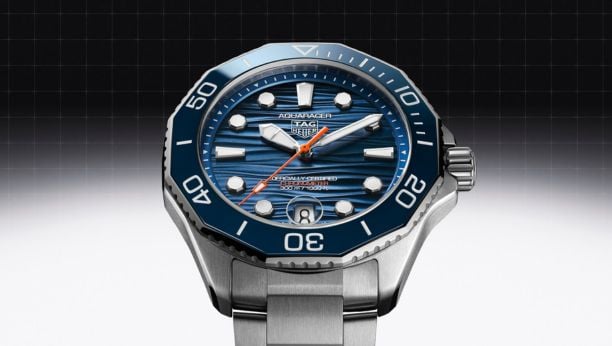VINTAGE COLLECTION
HEUER JARAMA
The “third-generation” of Calibre 12 powered chronographs offers collectors interesting choices, as Heuer dialed back the outrageous styles of the early-1970s models and expanded its catalog to include bi-metallic cases and bracelets, black-coated cases (with the Monza) and integrated cases and bracelets (with the Cortina and Daytona). The Jarama takes its place in this range as a watch that combines the sporting energy of the legendary Spanish Formula 1 track with the elegance of a chronograph that is well-suited for the country club or luxurious vacation destination.
Heuer’s Calibre 12 powered chronographs from the 1970s evolved through three distinct generations. First came the “launch models”, the Autavia, Carrera and Monaco, introduced to the world as the first automatic chronographs in March 1969. The second generation of Calibre 12 chronographs, beginning in 1971, captured the wild style of the 1970s – the oversized but very useful Calculator, the Montreal with its vibrant colors, and the Silverstone, with its distinctive blue, red or fume tones on the dial. For its third generation, which made its debut in 1977, Heuer dialed back the exuberance and overstatement of the predecessors, with a range of chronographs that captured the energy of racing as well as an elegant style that would be suitable for high end clients with a globetrotting lifestyle.
For this third series of Caliber 12 chronographs, Heuer used names of legendary places. The Daytona, Jarama and Monza are associated with motorsports; Kentucky is among the most famous locations for horseracing; and the names Cortina and Verona represent Heuer’s association with the lifestyle of Italian jet-setters.
The Jarama chronograph demonstrates the essence of this third generation of Calibre 12 chronographs, capturing the energy and excitement of the legendary Spanish racetrack, along with the glamour of Formula 1. The Jarama racetrack is often associated with Gilles Villeneuve, who triumphed at Jarama in what is regarded as one of the great battles in Formula 1 history. Of course, Villeneuve was an enthusiast of Heuer chronographs, usually wearing the Autavia and Chronosplit models.
JARAMA CIRCUIT
The Circuito del Jarama is a racetrack built in 1967 on the outskirts of Madrid. Home to the Spanish Formula 1 Grand Prix a total of nine times, the last Spanish Grand Prix held at the location took place in 1981 and was won by Ferrari’s Gilles Villeneuve. It would turn out to be Villeneuve’s last victory and the closest finish in Grand Prix history, with the first five cars covered by 1.2 seconds.
Vintage car enthusiasts will also recall the Lamborghini Jarama of the early 1970s. Despite the shared name, the Lamborghini is not named after the F1 circuit, but rather the area around the Jarama river, a region where many of the fighting bulls are bred.
HEUER JARAMA

The Heuer Jarama first appeared in the 1977 Catalogue and was offered as three models, each of which were powered by Heuer’s Chronomatic Calibre 12 movement. The three models shown in the 1977 catalog were the reference 110.245, with its black dial and gold-fluted bezel, the reference 110.225, with its champagne dial and gold-fluted bezel, and the reference 110.223, which has a black dial and distinctive black-coated bezel.
The Jarama chronograph has a shapely cushion-style case of 39mm, with a combination of a polished lower portion and a sunray brushed top section. The chronograph pushers are nicely integrated into the case, giving the watch a smooth style. Chronograph registers of the Jarama match the dials, contributing to the elegant style of the watches. Each model has an inner bezel that also matches the color of the dial, with scales marked for Tachymeter (60 to 220 units per hour) and Pulsations (with the scale reading 200 to 60, based on a count of 15 pulses).
The Jarama was one of the first Heuer or TAG Heuer watches to be offered in a variety of “bi-metal” finishes - a combination of gold-plating and stainless steel. The 110.245 features a stainless steel case with a fluted gold bezel, and a black dial. White hands for the time-of-day and chronograph ensure optimal legibility.
The second Jarama takes the bi-metal concept even further, with a Champagne coloured dial and inner bezel, and a bi-metallic gold and steel bracelet. Hands for the time-of-day and chronograph recorders are black, consistent with the drive for legibility across the Jarama line-up.

JARAMA 110.223
The reference 110.223 version of the Jarama may be the most sporting of the three models, with a style of bezel used only on this one model. The bezel is flat, rather than fluted, with a black coating that is well-matched to the matte paint on the dial. The NSA bracelet used for this Jarama continues the theme, with a combination of black and stainless steel links.
THE MYSTERIOUS WHITE GOLD BEZEL
Though not shown in any catalogs or other official literature, there is a fourth version of the Jarama. The case is marked 110.245, but rather than having the gold-fluted bezel of the standard model (which is created through a plating process), the bezel is white gold. This model is exceptionally rare, with only a handful of samples being known to the collectors community.







